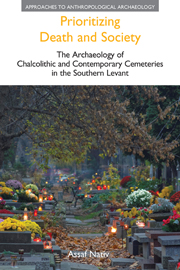 Prioritizing Death and Society
Prioritizing Death and Society from Part II - Chalcolithic cemeteries
Only two examples of Chalcolithic cemeteries in active karstic systems are known to date: the Peqi'in Cave in the Upper Galilee (Gal et al. 1997, 1999, 2007, 2011) and the Nahal Qanah Cave in the Samarian Mountains (Gopher & Tsuk 1996). Unlike other burial-cave cemeteries that are found fairly close to each other, these two are located almost 100 km apart. While this may be due to a variety of factors (chance of recovery, association with sparsely settled areas, etc.), it may also suggest that these two caves differed along culturally significant lines as well. This is an issue to which we shall return towards the end of the chapter. First, however, a concise review of both cases will be presented with particular emphasis on the skeletal remains, modes of deposition and the composition of the funerary assemblages. The remainder of the chapter will consider their lines of similarity and difference.
Peqi'in Cave
Peqi'in Cave is the northernmost Chalcolithic cemetery known to date, located in the Upper Galilee. It was discovered during road construction, and was subsequently excavated from May to August 1995. The largest and richest Chalcolithic funerary assemblage known thus far was found in this cave, consisting of an extraordinary variety of artistic/symbolic expressions, materials and the osseous remains of many hundreds of individuals. This account will focus on a few aspects of the data; the reader is encouraged to explore the preliminary reports published so far (Gal et al. 1997, 1999, 2007, 2011).
To save this book to your Kindle, first ensure no-reply@cambridge.org is added to your Approved Personal Document E-mail List under your Personal Document Settings on the Manage Your Content and Devices page of your Amazon account. Then enter the ‘name’ part of your Kindle email address below. Find out more about saving to your Kindle.
Note you can select to save to either the @free.kindle.com or @kindle.com variations. ‘@free.kindle.com’ emails are free but can only be saved to your device when it is connected to wi-fi. ‘@kindle.com’ emails can be delivered even when you are not connected to wi-fi, but note that service fees apply.
Find out more about the Kindle Personal Document Service.
To save content items to your account, please confirm that you agree to abide by our usage policies. If this is the first time you use this feature, you will be asked to authorise Cambridge Core to connect with your account. Find out more about saving content to Dropbox.
To save content items to your account, please confirm that you agree to abide by our usage policies. If this is the first time you use this feature, you will be asked to authorise Cambridge Core to connect with your account. Find out more about saving content to Google Drive.